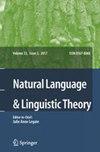重新分析 "说 "的互补性:对案例理论及其他方面的影响
IF 1.1
1区 文学
0 LANGUAGE & LINGUISTICS
引用次数: 1
摘要
本文章由计算机程序翻译,如有差异,请以英文原文为准。
Re-analyzing ‘say’ complementation: Implications for case theory and beyond
求助全文
通过发布文献求助,成功后即可免费获取论文全文。
去求助
来源期刊

Natural Language & Linguistic Theory
Multiple-
CiteScore
3.00
自引率
7.70%
发文量
24
期刊介绍:
Natural Language & Linguistic Theory provides a forum for the discussion of theoretical research that pays close attention to natural language data, offering a channel of communication between researchers of a variety of points of view. The journal actively seeks to bridge the gap between descriptive work and work of a highly theoretical, less empirically oriented nature. In attempting to strike this balance, the journal presents work that makes complex language data accessible to those unfamiliar with the language area being studied and work that makes complex theoretical positions more accessible to those working outside the theoretical framework under review. Natural Language & Linguistic Theory features: generative studies on the syntax, semantics, phonology, morphology, and other aspects of natural language; surveys of recent theoretical developments that facilitate accessibility for a graduate student readership; reactions/replies to recent papers book reviews of important linguistics titles; special topic issues. Springer fully understands that access to your work is important to you and to the sponsors of your research. We are listed as a green publisher in the SHERPA/RoMEO database, as we allow self-archiving, but most importantly we are fully transparent about your rights. Read more about author''s rights on: http://www.springer.com/gp/open-access/authors-rights
 求助内容:
求助内容: 应助结果提醒方式:
应助结果提醒方式:


